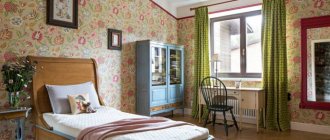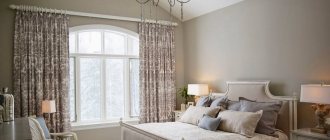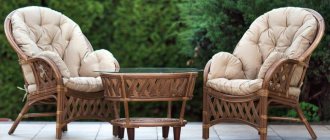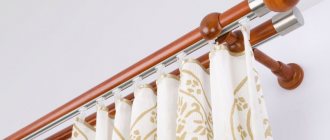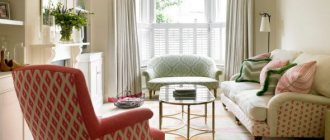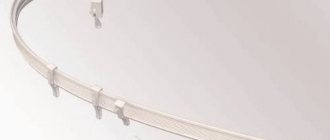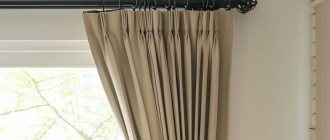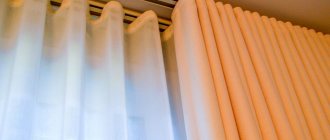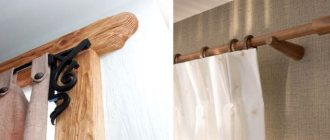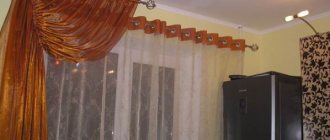How to choose a cornice
The first step is to decide on the curtains. When studying the variety of types of curtains, be guided by the chosen interior style. For example, single curtains are suitable for minimalist designs, and double curtains with decor are suitable for classic designs.
The crossbar must be selected strictly for a specific type of curtain. Recommendations from designers to help:
- Consider the weight and design of the curtains. For models made of light fabrics, any type of cornice is suitable. For heavy curtains, it is better to choose durable designs. For example, ceiling or wall with several brackets.
- Consider what kind of curtain mounts you want to use. It is important that the fasteners move freely along the cornice and fit the design.
- Assess the location of the window sill. If it is high, it is better to give preference to ceiling models.
- Pay attention to where the heating radiators and pipes are located. The structures should not interfere with the free hanging of curtains.
Advice! If the room already has cornices, when choosing, be guided by their appearance and design.
Example of a curtain rod
Choosing fabric for curtains
Curtains located next to open windows inevitably become dirty with dust from the street. The need for frequent washing dictates the choice of fabric, which must be durable and not subject to deformation.
The most suitable for this purpose are translucent organza, veil, chiffon and the usual tulle.
Types of curtain rods by mounting method
All fastenings are divided into two large groups - wall and ceiling. Let's figure out how to attach cornices, weigh the pros and cons for each option.
| View | What is this | Advantages | Flaws |
| Wall mounted | Designs for wall mounting. They consist of brackets and strips for hanging canvases. | 1. Models in any style. 2. Easy installation. 3. Options for light and heavy curtains. | 1. Large load for plasterboard walls. 2. Partial transmission of sunlight through the rods. |
| Ceiling | Structures that need to be fixed to the ceiling | 1. Visually raise the ceilings. 2. Help to disguise wide window sills. | 1. Difficulties when installing on a ready-made stretch ceiling. 2. Small variety of design options. |
Important! You should not use traditional cornices for a suspended ceiling. The canvas may not withstand the load.
Ceiling curtain rod for bay windows
Wall mounted metal curtain rod
Useful tips for installing and caring for curtains
Regardless of the choice of cornice installation method, you need to consider the following important points:
- Often the dimensions of the cornice do not correspond to individual needs, so it is better to cut off the excess. This needs to be done accurately and carefully - use a miter box, or you can ask to do the work right away in the store if the exact parameters are known.
- If you purchased a round curtain rod, then between the bracket and the tip it is better to place 1 ring or other clamping device that will fix the curtain at one edge - in this case it will not “move” from side to side.
- When installing curtains, it is important to fasten the clips at the same distance to avoid unsightly folds. The interval between the nearest clamps is optimally 10 cm.
- If you use clips, it will be correct to constantly alternate them with rings, since in this case the curtain will be attached stronger and fewer folds will form.
- If the curtains are wider than 2 meters, then an additional central bracket is installed in the center of the cornice - this will make the system much more reliable.
- Curtains often get dirty if you open and close them with your hands, so it is better to purchase a special driver, which is very affordable, and at the same time, thanks to it you will not have to wash the canvas as often.
- You can choose tips or clips separately - they are the ones who create the individual design of the curtains and cornices. The clips look great, in the form of a pattern. corresponding to the pattern of the curtains (stars, waves, zigzags, etc.)
Hidden cornice: features and advantages
In addition to traditional ceiling and wall cornices, there are hidden structures. This is the best option for stretch fabrics.
The structure with curtains will be hidden in a niche, which is specially created when installing the canvas. A bus bar made of plastic, metal or wood is placed in the recess. That is, in fact, you will get a ceiling cornice that will be hidden from view.
Advantages of hidden structures:
- The ceilings are visually raised.
- Suitable for different curtain options.
- They create the effect that the curtains fall straight from the ceiling.
- Suitable for placing hidden lighting and motion sensors.
The only disadvantage of hidden cornices is their complicated installation. It is important not to make a mistake with the depth of the niche. The minimum value is 10 cm. This recess is suitable for curtains without decoration. If you plan to hang curtains with a lambrequin, make a niche 15-20 cm deep.
The second important indicator is the width of the niche. When measuring, you need to start from the type of window sill. The more it protrudes, the wider the niche should be. The optimal indicator is 15-25 cm.
Hidden cornice for suspended ceiling
When do you choose cornices?
The task of buying curtain rods arises in several cases. And in every situation the need for this accessory will be completely justified:
- When completing renovations in a room and decorating windows in accordance with the overall style of the room.
- Updating the appearance of a room at minimal cost. New curtains will help solve this problem, but often you will need to change the curtain rod.
- The breakdown of an old structure may be the reason for going to the store for a new one.
- The cornice is going out of fashion and there is a need to update it.
Options for curtain rods by material type
The durability and reliability of structures directly depends on the material. Let's discuss what kinds of cornices there are and what their features are.
Metal
Manufacturers most often use stainless steel or brass to make curtain rods. There are two types of metal products on sale: forged and cast. Both curtain holders are equally reliable.
Metal curtain rods can withstand heavy curtains without bending or breaking. However, there is also a minus - a massive design. For this reason, metal crossbars should not be mounted on plasterboard walls.
Important! If the crossbar is longer than 1.5 m, additional brackets will be required to secure it.
Metal cornice with decorative element
Wooden
Wooden cornices are made from beech, birch, walnut and other types of wood with pronounced natural patterns. The crossbars last a long time - the minimum service life is 5 years.
In the assortment of wooden structures you will find baguette, round, spacer models, and cafe cornices. You can choose designer products to suit a specific interior style.
Wooden cornice with baguette
Plastic
Most plastic models are ceiling-mounted. The range also includes round designs for wall mounting, but they are only suitable for light curtains.
Plastic curtain rods are less strong and durable than wooden and metal ones. But in this category there are more design options. In modern interiors there are often models stylized as wood or painted in unexpected bright shades.
Plastic cornice with baguette
Combined
To make such cornices, combinations of materials are used. For example, the bar may be wooden, and the brackets may be metal. Or vice versa. The photo shows an impressive combined model that will make window decoration even more attractive.
Curtain rod made of metal and wood
Models and prices
Approximate prices in rubles for different models of wall-mounted curtain rods are presented in the comparative table.
| model | price |
| 2490 | |
| 240 | |
| 2490 | |
| 749 | |
| 230 | |
| 1790 |
Thus, the price is mainly influenced by the material of the product: the most expensive are metal, medium-priced wooden and the most affordable are plastic curtain rods.
Types of curtain rods by appearance
The aesthetic appeal of curtain slats is not the last parameter of choice. However, it is important that the fastenings are not only beautiful, but also comfortable. We offer seven varieties of curtain rods that meet these requirements.
Round
Round or tubular cornice is the most popular variety from the range. The design is a solid, sliding or composite rod with tips.
You can choose standard single-row models and double-row designs for attaching double curtains. The second element of the cornices is designed to fix light fabrics, therefore it has a smaller diameter.
Round curtain rod with shaped tip
Baguettes
Baguette cornices consist of a fastening profile and a decorative strip that hides pipes and strings. The result is an impressive design for curtains and drapes.
Ceiling cornice with baguette
Strings
Cornices consist of two brackets and a thick string between them. If you plan to hang multi-layer curtains, give preference to products with several slats.
Brackets and strings are most often made of stainless steel. The second option is products made from polymers. However, such cornices have much less strength.
Advice! Place curtains made of light fabrics on string cornices. The structure may break under the weight of the curtains.
Metal string curtain rod
Tire
Busbar or profile cornices are plastic panels with several rows for hooks. These mounts are suitable for ceiling and wall mounting. In the second case, brackets will be required for fixation.
Curtain rods can have one, two or three rows. Some models are equipped with an electric drive for remote control using a remote control.
Tire multi-row curtain rod
Telescopic
Such cornices are also called stained glass. The structures consist of two elements of different diameters and tips. If necessary, you can easily increase the length of the rod by spreading the tubes.
Telescopic structures can be mounted on walls or directly on the window frame. For the second method, curtain rods that are equipped with brackets with a sticky base are suitable.
Telescopic vintage curtain rod
Cornices-cafe
Lightweight designs with thin rods and shaped tips. They are designed to be mounted directly to the frame. Most often they are mounted at the level of the middle of the window to hang spectacular decorative curtains.
Cafe curtain rod for curtains
Spacers
Spacer cornices are a rod with a spring inside. Such structures do not need to be mounted on brackets - they are held perfectly in the openings due to plastic or rubber tips.
Metal spacer cornice
Decorative function of cornice
In addition to their functional function, cornices also perform a decorative function. If you look into history, this simple object was used only for fastening, and it did not represent anything worthwhile.
Often it was just a stick, without any patterns. It was easy to hang curtains on them, they did not fall and moved in the right direction.
But time moves inexorably forward, and curtain rod manufacturers create new models. Now these are not just devices for holding curtains, they are decorations for the room. The cornices are made in different styles and different colors.
Modern cornices can be called masterpieces of art. The products are so different and unique that they will decorate absolutely any room and complement any design solution.
Types of cornices of different shapes with photos and descriptions of mounting to the wall
We have already analyzed the types of cornices by design, installation method and materials. It's time to discuss the configuration of the structures. Here are six possible options.
Round
Many people confuse these curtain rods with regular round rods. However, there are non-standard designs designed for attaching partitions or textile decor.
Most designs from this category look like in the photo. The barbell in the form of a hoop is fixed to strips fixed to the ceiling.
Ceiling round cornice for decorative curtains
Semicircular
Semicircular or arc cornices are designed for decorating bay windows and placing decorative textile elements. The products are curved round rods made of metal or plastic. Most often they are fixed on figured brackets.
Ceiling semicircular curtain rod
Direct
Cornices for standard window openings. They can be either wall or ceiling. A distinctive feature is the absence of bends. A popular option from this category is shown in the photo.
Straight wall curtain rod
Corner
A corner cornice is an indispensable attribute for decorating windows located on adjacent surfaces. This is a convenient option if you don't want to mount two separate bars or bars.
The process of installing corner elements is simple - just fix the ends of the curved crossbar on two walls or ceiling. In the photo you will see how to do this.
Corner ceiling curtain rod
L-shaped
Such cornices are a type of corner cornices, so they need to be fixed according to a similar principle. The only difference between the L-shaped models is that one side of the bar is much shorter than the other.
Important! L-shaped crossbars are indispensable if you need to hang a mini-curtain or a fabric partition in a room for zoning.
L-shaped curtain rod
Rotary
Rotating cornices are curved rods with movable elements. If desired, you can easily change the bending radius and mount the mount on window openings of a non-standard configuration.
Swivel curtain rod for bay windows
Flexible
Such cornices are an aluminum or plastic strip with rows for fastenings. Flexible designs are suitable for window openings of non-standard shape.
Cornices can be used not only for placing curtains on windows, but also for installing screens, canopies, and curtains in doorways.
Flexible curtain rod for custom-shaped window openings
Advice! Flexible cornices are suitable for decorating windows in bay windows of various shapes.
Curtains for different rooms
There are several types of curtains and curtains for different uses:
Bedroom. Thick fabric in soothing tones will symbolize privacy and alienation from the world outside the bedroom window. This implies a correspondence between the styles of curtains, curtains and the room.
Living room. The center of attention should be the window decor. Multilayer curtains that match the style of the room, together with curtains with picturesque drapery and lambrequins, will create an unforgettable image of the living room.
Children's room. Easily extendable and durable, curtains can be decorated with images of fairy-tale and cartoon characters.
Kitchen. Since curtains are exposed to the most dirt in the kitchen, the material from which they are made should be able to easily withstand frequent washing, their length should be reduced, and decorations should be kept to a minimum.
Well-chosen elements for window design create an attractive image of the owners of the house as fairly wealthy people who are familiar with aesthetics.
Types of cornices by number of rows
Another important classification of curtain rods is based on the number of rows for placing curtains. Three categories of designs:
- Single-row: round, string, profile. Designed for fastening one blade.
- Double-row: tire, baguette, round. Suitable for double curtains.
- Three-row: tire structures with grooves for fastenings. The range also includes wall-mounted round cornices with extended brackets for fixing the crossbars. With the help of such systems, you can place several canvases and textile decor, for example, lambrequins.
Single row curtain rod
Double row curtain rod
Three-row rail curtain rod
Cornices in the interior: photo examples
A properly selected curtain rod can significantly transform the appearance of a room. It can visually adjust the height of the ceiling and the width of window openings. In non-residential premises decorated in loft and minimalist styles, the simplest designs will look harmonious. String and metal profiles look good in such styles. Examples can be seen in the photos below.
Round cornices will help to emphasize the home environment of Provence, classic, and country style. Forged and wooden options would be ideal. Natural wood and beautiful designer forging will make the interior unique. Baguette models fit perfectly into the Art Nouveau style. A decorative removable panel with a bright design will help hide some wall defects and cover unsightly elements of the fastener. You can see successful options for combining interior style with various types of cornice in photo examples.
Types of eaves control
For ordinary curtains, a familiar mechanical curtain rod will do. You will have to control the position of the curtains manually, that is, you will have to move the curtains apart and move them yourself.
If you choose Austrian, Roman, French or Japanese curtains, you must purchase a motorized curtain rod. Possible options:
- Lifting devices. Systems for curtains that need to be lifted upward. Such models are ideal for Roman and Austrian curtains. Such cornices can be open or closed. The mechanisms are also distinguished by the control method and the maximum lifting height.
- Sliding devices. Such electric curtain rods are suitable for various roll sheets that will be moved apart horizontally. For example, Japanese curtains. The system consists of a sliding mechanism, an electric drive and a structure for manual control.
- Combined devices. Such cornices are suitable for curtain panels. This system combines the ability to manually control and move the blades using an electric drive.
You can control the curtain rods using levers or remote controls. Many manufacturers have already begun to equip devices with special sensors that respond to movements or lighting levels. These models are compatible with the smart home system.
Electric sliding curtain rod
Photo for inspiration
PreviousCurtainsHow to stick tulle on a window using starch
Next
CurtainsChoice of curtains for a window with a balcony door for the hall, living room and bedroom
How to attach curtains to a cornice: options with photos
If you have already chosen a curtain rod, it's time to think about how to hang curtains correctly. Let's look at different methods.
Kuliska
This fastening is the simplest option for curtains and light curtains. The first step is to make a drawstring. It is enough to fold the top edge of the fabric and carefully sew along the entire length of the fabric. You should get a fairly wide hole into which to insert the rod.
Drawstring fastening is suitable for wall round cornices. The first step is to hang the curtains, and then attach the bar over the opening.
Lightweight drawstring curtains
Loops
To secure the curtains, you need to sew fabric loops to the top of the curtains. If you want the curtains to hang in neat folds, place the fasteners at an equal distance from each other.
Advice! The design will look more aesthetically pleasing if the loops are made approximately 1.5 times wider than the rod.
Fixing curtains on hinges
Ties
The tie fastening is very similar to the loop method. You need to sew beautiful ribbons to the top of the fabric, then tie them one by one above the bar.
This option is not suitable for all interior styles. Bow ties on the curtains will fit well into such trends as retro Provence, country, eco, pop art.
Fixing curtains with ties
Rings
This method differs from the previous ones in that you must first string the clamps onto the rod and only then hang the curtains. Rings can be attached to fabric using special hooks or clips.
Feel free to use this method if you want to hang heavy curtains. The fasteners will not break under load - they are designed for quite a large weight of curtains.
Fixing curtains with rings
Advice! It is better to use rings that are sold with a cornice. If they are not included in the kit, you must choose fasteners made of a similar material.
Eyelets
Eyelets are neat, equally spaced holes in the upper part of the fabric. It is through them that the cornice rod will pass.
This method is suitable if you have chosen thin metal or wooden cornices. However, consider the type of curtain fabric. Eyelets do not always look appropriate on airy, lightweight fabrics.
Fixing curtains with grommets
Hooks
Fastening with hooks is suitable for closed cornices: rail, baguette. The fasteners do not have a decorative function, so they look unpretentious. Most often they are made of plastic and metal. The first option is preferable for light curtains, the second for heavy curtains.
Fixing curtains on hidden hooks
Clothespins
Clothes pins for curtains are otherwise called “crocodiles” or “crabs”. They are compatible with both closed track structures and round cornices. In the second case, the fastenings will be conspicuous, so the type of fabric must be taken into account. Ordinary metal “crabs” will effectively complement heavy curtains made of velvet, brocade, and jacquard. For light curtains, it is better to choose convenient magnetic clips. They hold the canvas tightly without damaging the fabric.
Fixing curtains with crocodile clips
With our tips, choosing a cornice will turn into an exciting experience. You will cope with the task perfectly!
Curtain width
When the curtains cover a window, their edges should touch in the middle, and the width of the straightened canvases should match the length of the cornice. If the curtains or curtain rod are not matched correctly, the curtains may not meet in the middle or excess fabric may become noticeable. Therefore, when choosing ready-made curtains, you need to check what width is indicated on the label.
Curtains on large windows Source vi.aviarydecor.com
To determine the width of the curtains, you need to know the coefficient of gathering (pomp) of the curtain. Its value depends on the density of the material and the type of folds:
- 3.5 – for curtains made of thin fabrics (organza, mesh, etc.) you will need material 3.5 times the length of the cornice;
- 2.5 – if the fabric is of medium density;
- 1.5-2 – for thick fabrics;
- 1.5-2 – if the curtains are on hinges;
- 2 – for curtains with eyelets or with triple folds, standard curtain tape;
- 2-2.5 – for curtains with pencil folds;
- 2.5 – with buffs.
Lambrequin in a hall in a classic style Source sakhexpo.ru
How to calculate the width of curtains:
- The length of the cornice is multiplied by the fabric gathering factor.
- The resulting value is divided by the number of canvases.
Thanks to a simple algorithm, you can easily determine the correct width of the curtains.
Choosing a cornice model
Today, among ceiling cornices there are many models that differ in their properties, care features and design. On store shelves, the buyer can find the following types of accessories:
- Tire options.
- Cornices-plinths.
- Flexible models.
- Baguette cornices.
- Rods with a round base.
- String options.
Each type of cornice differs in material of manufacture, external decor and color. For the optimal choice of a particular model, a number of features and factors should be taken into account: room area, ceiling height, weight and number of textile fabrics, structure of the ceiling base (for suspended ceilings it is necessary to use special ceiling cornices).
Profile option
Curtains move along guides in the form of profiles. The clamps are attached to them. In such “bus” curtain rods, several rows of profiles can be used, which makes it possible to use multi-layer curtains. But a flexible curtain rod is suitable for any shape in accordance with the geometry of the window.
This design is usually mounted on the ceiling, although there are wall-mounted models with special brackets. The front side is usually decorated.
Round base rods
These curtain rods are made of various metal alloys (with the exception of aluminum). They have a pleasant external decor and a glossy surface texture. They are easy to maintain and resistant to corrosion, thanks to the foresight of the manufacturers.
The surface of the bar can be absolutely smooth, or it can be made in the form of a relief ornament. The advantage is the special strength of the product, the ability to withstand significant weight of textiles.
Disadvantages of ceiling models
Among the disadvantages of practical choice, the following provisions should be noted:
- When installing a ceiling cornice, you may need the help of a specialist.
- The need to use the most reliable fastenings.
Stretch ceilings can be particularly difficult, which poses a problem for attaching ceiling cornices.
